Table of Contents
Objective of Respiration
Energy Release- Respiration is fundamentally about releasing energy stored in the food. This energy is essential for various functions and activities of the cells such as nutrition, transport, excretion, and reproduction.
Cellular Respiration
- Definition- Cellular Respiration is a process where the food (glucose) is broken down in cells, releasing energy.
- Oxygen’s Role- Oxygen aids in the breakdown of glucose, resulting in the release of energy, carbon dioxide, and water.
- What Happens- In cellular respiration, glucose from the food we consume is broken down into simpler substances like carbon dioxide and water, releasing energy in the process.
- Where it Happens- This process occurs at the cellular level, in the mitochondria of the cells.
Breathing and its Relationship with Respiration
- Breathing- This is the process where organisms inhale oxygen from the environment and exhale carbon dioxide. It is a physical process.
- Connection with Respiration- Oxygen inhaled is used in the cells for breaking down glucose, and the carbon dioxide generated during this breakdown is expelled from the body.
Also Check – Why Do We Get Out of Breath When We Exercise?-Explained for Kids
Types of Respiration
Aerobic Respiration
- Presence of Oxygen- This type of respiration happens in the presence of oxygen.
- Products- The complete breakdown of glucose results in carbon dioxide and water, extracting maximum energy.
Anaerobic Respiration
- Lack of Oxygen- Happens when there is no oxygen available.
- Products- Results in the incomplete breakdown of glucose, producing alcohol and carbon dioxide. Seen in organisms like yeast.
Adaptability in Respiration
- Organisms like Yeast (Anaerobes)- Can adapt to environments without oxygen, getting energy through anaerobic respiration.
Physical Activities and Respiration-
- Increased Demand for Energy- When involved in strenuous physical activities, the body’s demand for energy increases, causing an increase in breathing rate.
- Purpose- More oxygen is required to produce more energy to meet the body’s demands during the activity.
Also Check –Rapid Revision – Class 7 Science- Chapter 10- Respiration in Organisms
Role of Food in Respiration-
- Source of Glucose- The food consumed acts as a source of glucose, which is a primary substrate for respiration to occur.
Respiration, whether aerobic or anaerobic, is vital for organisms, ensuring that cells receive the necessary energy to function. Breathing plays an instrumental role in respiration, facilitating oxygen intake and removal of carbon dioxide, thus supporting cellular activities and overall life processes.
Aerobic Respiration in Animals (including Humans)-
- Equation- C6H12O6 (glucose) + 6O2 (oxygen) → 6CO2 (carbon dioxide) + 6H2O (water) + Energy
- Explanation- In aerobic respiration, one molecule of glucose reacts with six molecules of oxygen, producing six molecules of carbon dioxide, six molecules of water, and releasing energy in the form of ATP (Adenosine Triphosphate).
Anaerobic Respiration in Animals (including Humans)-
- Equation- C6H12O6 (glucose) → 2C3H6O3 (lactic acid) + Energy
- Explanation- In the absence of oxygen, glucose is broken down into lactic acid, releasing energy. This is common in muscles during intense exercise when the oxygen supply is limited.
Anaerobic Respiration in Yeast (Fermentation)-
- Equation- C6H12O6 (glucose) → 2C2H5OH (ethanol) + 2CO2 (carbon dioxide) + Energy
- Explanation- Yeast undergoes anaerobic respiration in the absence of oxygen, resulting in the production of ethanol, carbon dioxide, and energy.
Anaerobic Respiration in Muscle Cells During Exercise
Anaerobic Respiration in Muscle Cells-
- When it Occurs- Takes place during heavy exercise due to a temporary deficiency of oxygen. Examples include fast running, cycling, prolonged walking, or heavy weight lifting.
- Why it Occurs- The body’s demand for energy is high during strenuous activities, but the supply of oxygen to produce energy is limited.
Muscle Cramps-
- Cause- Due to the anaerobic respiration in muscles, there is a partial breakdown of glucose into lactic acid. Accumulation of lactic acid leads to muscle cramps.
- Relief Methods- Hot water baths or massages can alleviate the cramps because they improve blood circulation, increasing the oxygen supply to the muscles.
Effect of Improved Oxygen Supply-
- Breaking Down Lactic Acid- When the oxygen supply increases, it results in the complete breakdown of the accumulated lactic acid into carbon dioxide and water.
- Outcome- This helps in relieving the muscle cramps experienced after heavy exercises.
Breathing Rate Variability Based on Activity Levels
Objective
- Exploring Breathing Rates- To observe and understand how breathing rate varies based on the body’s oxygen requirements due to different activities.
Experiment Details
- Normal State- Count the number of times you inhale and exhale in a minute under normal resting conditions.
- After Physical Activity- Repeat the counting after engaging in activities like brisk walking and running. Record the breathing rates immediately after and then again after complete rest.
Observations and Findings
- Breathing Rate Variability- The breathing rate changes based on physical activity levels. It increases when the body requires more oxygen, like during physical exertion.
- Correlation with Energy Needs- Faster breathing rates during physical activities facilitate increased oxygen supply, promoting a quicker breakdown of food for energy.
Analysis and Insights
- Connection with Hunger- Enhanced physical activity, facilitated by increased breathing rates, leads to quicker energy utilisation, possibly explaining the feeling of hunger post-activity.
- Variability in Daily Activities- Different daily activities, from resting to exercising, lead to variable breathing rates, corresponding with the body’s fluctuating oxygen and energy needs.
The breathing rate is a dynamic aspect of human physiology, directly correlated with the body’s oxygen and energy requirements. An experiment involving observation of breathing rates under various physical activity levels reveals this variability, helping us understand the body’s adaptive mechanisms to meet oxygen and energy demands. The higher breathing rates during physical exertion ensure an adequate oxygen supply for enhanced energy release, which also correlates with feelings of hunger due to increased energy consumption.
Detailed Mechanism of Breathing

Pathway of Inhaled Air
- Nostrils- Entry point of air; acts as a filter, warming and humidifying the inhaled air.
- Nasal Cavity- Filters, warms, and moistens the incoming air further, preparing it for the lungs.
- Windpipe (Trachea)- Conducts the cleaned and warmed air from the nasal cavity to the lungs; a tubular passage for inhaled and exhaled air.
Anatomical Structures Involved in Breathing
- Ribs- Protective bony cage around the chest, assisting in the breathing process by moving up and down.
- Diaphragm- Dome-shaped muscle beneath the lungs, playing a crucial role in inhalation and exhalation by changing the thoracic cavity’s volume.
Mechanism of Breathing

Inhalation (Inspiration)
- Ribs Movement- The ribs move upwards and outwards, expanding the chest cavity.
- Diaphragm Movement- The diaphragm contracts and flattens, increasing the chest cavity’s space.
- Airflow- Due to the increased volume in the chest cavity, outside air flows into the lungs, filling them.
Exhalation (Expiration)
- Ribs Movement- The ribs move downwards and inwards, decreasing the chest cavity’s size.
- Diaphragm Movement- The diaphragm relaxes and resumes its dome shape, reducing the chest cavity’s volume.
- Airflow- The decreased thoracic volume pushes the air out of the lungs, expelling it into the atmosphere.
Physical Observation and Self-Exploration
- Abdomen Movement- Placing a hand on the abdomen allows for the physical sensing of the diaphragm and abdominal muscles’ movements during breathing.
- Activity- An experiential learning activity like a chest expansion competition can be a fun way to physically explore and understand the breathing mechanisms further.
Understanding through Activities
- Engaging in practical and playful activities allows for a more in-depth understanding and appreciation of the breathing mechanism’s functionality and adaptability in different situations and needs.
Breathing is a meticulously coordinated process involving various anatomical structures like the nostrils, nasal cavity, windpipe, ribs, and diaphragm. These structures work synergistically through specific movements and adaptations during inhalation and exhalation, enabling efficient air flow into and out of the lungs. This harmonised mechanism ensures that the body’s cells are continuously supplied with the oxygen necessary for metabolic processes and that waste products like carbon dioxide are effectively removed.
Activity – Understanding the Breathing Mechanism Through Measurement and Observation
Objective
- To understand the breathing mechanism better by measuring and observing the chest’s expansion and contraction during breathing.
Activity Procedure
Taking a Deep Breath-
- Begin by taking a deep, deliberate breath. Inhale air until your lungs feel full.
Measurement of Chest Size-
- Use a measuring tape to measure the chest’s circumference. Ensure the tape is snug but not tight.
- Record the measurement for later comparison.
Observation and Recording
Expanded Chest Measurement-
- While keeping the chest expanded, measure the circumference again.
- Ensure accuracy and consistency in the measurement point to get a true comparison.
Comparison and Analysis
Comparing Measurements-
- Analyse the differences between the normal and expanded chest measurements.
- Identify the classmate with the maximum chest expansion.
Understanding Through Model-
- Using the measurements and comparisons, one can understand the breathing mechanism better, visualising the lung’s expansion and contraction.
Learning Outcomes
- Mechanism Visualization- This activity helps in visualising the breathing mechanism, understanding how the chest and lungs expand and contract.
- Practical Insight- Measuring the chest expansion gives a practical insight into how much air the lungs can hold and the flexibility of the chest and lung tissues.
Activity – Understanding the Mechanism of Breathing Using a Model
Objective
- To create a visual representation of the breathing mechanism by constructing a simple model, facilitating a deeper understanding of the inhalation and exhalation processes.
Materials Needed-
- Wide plastic bottle
- Y-shaped glass or plastic tube
- Two deflated balloons
- Rubber or plastic sheet
- Large rubber band
Model Construction-

- Preparing the Bottle-
- Remove the bottom of the bottle.
- Make a hole in the lid to fit the Y-shaped tube.
- Setting up the Tubes and Balloons-
- Attach two deflated balloons to the forked ends of the Y-shaped tube.
- Insert the tube into the bottle and secure the lid.
- Sealing the Model-
- Attach a thin rubber or plastic sheet at the open base of the bottle.
- Ensure it’s airtight and securely fastened with a rubber band.
Conducting the Activity-
- Observing Lung Expansion-
- Pull the rubber sheet downwards.
- Observe any changes in the balloons (e.g., inflation).
- Observing Lung Contraction-
- Push the rubber/plastic sheet upwards.
- Observe the changes in the balloons (e.g., deflation).
Interpreting the Observations-
- Identifying Model Parts-
- Balloons represent the lungs.
- The rubber sheet represents the diaphragm.
- Understanding the Process-
- As the rubber sheet is pulled down (diaphragm contracts), the balloons inflate, simulating inhalation.
- Pushing the sheet up (diaphragm relaxes), deflates the balloons, simulating exhalation.
Conclusion and Learning-
- The model visually demonstrates the breathing mechanism, showing how the lungs expand and contract during breathing.
- It provides a hands-on way to understand the roles of the lungs and diaphragm in the breathing process, aiding in internalising and remembering the concept better.
Understanding Exhaled Air
Objective
To determine the components of exhaled air and their effects, specifically focusing on carbon dioxide.
Materials Needed-
- Slender, clean test tube or glass/plastic bottle
- Lid for the test tube/bottle with a hole
- Freshly prepared lime water
- Plastic straw
- Mirror
Procedure and Observations-
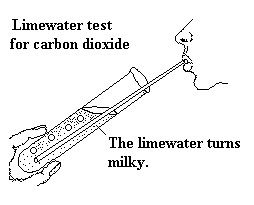
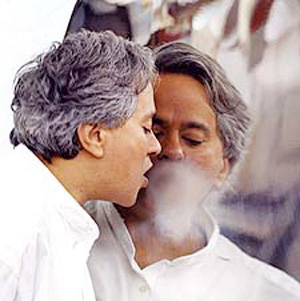
- Setting Up the Apparatus-
- Pour lime water into the test tube or bottle.
- Insert a plastic straw through the lid’s hole, ensuring it dips into the lime water.
- Experiment with Lime Water-
- Blow gently through the straw into the lime water multiple times.
- Observation- The lime water turns milky or cloudy.
- Experiment with a Mirror-
- Exhale onto a mirror.
- Observation- A film of moisture or condensation appears on the mirror’s surface.
Analysis and Concepts
Lime Water Test
- The lime water turns milky due to the presence of carbon dioxide in the exhaled air.
- This reaction occurs because carbon dioxide reacts with calcium hydroxide (lime water) to produce calcium carbonate, which is insoluble and causes the milkiness.
Mirror Test
- The moisture on the mirror is a result of water vapour present in the exhaled air.
Exhaled Air
- Air is a mixture of gases, including oxygen, carbon dioxide, nitrogen, and others.
- The air we exhale contains a higher concentration of carbon dioxide compared to the air we inhale. This is because our body produces carbon dioxide as a waste product during the process of cellular respiration.
- Apart from carbon dioxide, we also exhale other gases like oxygen (not used by our cells) and nitrogen (which remains largely unchanged). However, the proportion of oxygen in exhaled air is less than inhaled air.
- Exhaled air also contains water vapour, which is why we observe moisture when exhaling onto a cold surface like a mirror.
Breathing Mechanisms in Different Animals
Objective
- To understand the diverse respiratory systems and mechanisms in various animals.
Breathing in Mammals
- Examples- Elephants, lions, cows, goats
- Respiratory Organ- Lungs
- Mechanism-
- Inhale oxygen-rich air through nostrils/mouth
- Air travels down the trachea and fills the lungs
- Oxygen is absorbed into the bloodstream and carbon dioxide is expelled during exhalation.
Breathing in Insects
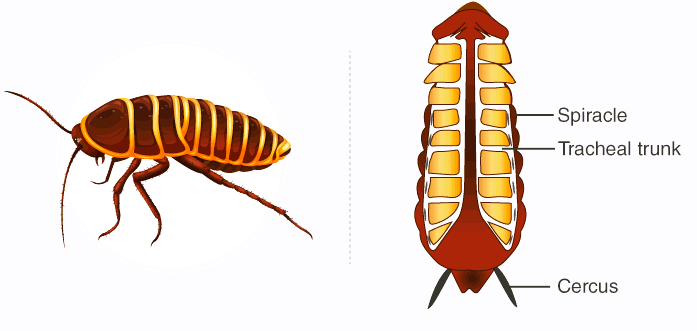
- Example- Cockroach
- Respiratory Organ- Tracheal system
- Features & Mechanism-
- Spiracles- Small openings on the sides of the body, act as entry and exit points for air.
- Tracheae- A network of air tubes that allow oxygen to diffuse directly into the body tissues, reaching every cell.
- Carbon dioxide from cells is expelled out through the spiracles.
- Note- This tracheal system is unique to insects.
Breathing in Annelids
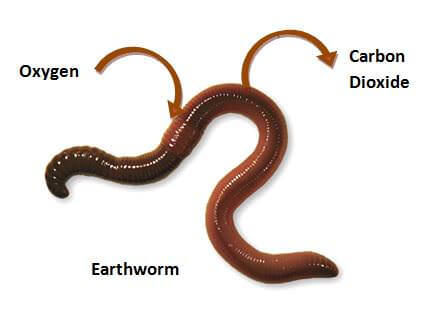
- Example- Earthworm
- Respiratory Organ- Skin
- Mechanism-
- Breathes through its skin which remains moist and slimy, allowing gases to diffuse easily.
- Does not have lungs or any specialised respiratory organs.
Breathing in Amphibians
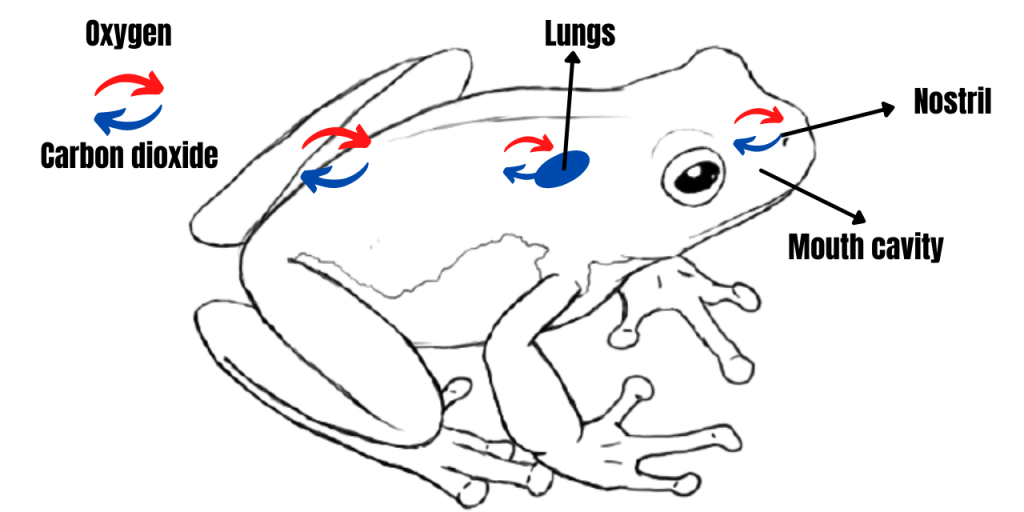
- Example- Frogs
- Respiratory Organs- Lungs and skin
- Mechanism-
- Frogs have lungs similar to humans and can breathe through them.
- Additionally, they can also respire through their moist and slippery skin which allows gases to diffuse directly into their bloodstream.
- This dual mechanism is particularly useful in diverse environments, both aquatic and terrestrial.
Different animals have evolved unique respiratory systems suited to their environments and physiological needs.
While many terrestrial animals utilise lungs, others like insects and certain amphibians have specialised systems or dual mechanisms for respiration.
The presence of a particular respiratory mechanism can give insights into an animal’s habitat, behaviour, and evolutionary history.
Breathing Underwater
Objective
- To understand how aquatic animals respire and utilise oxygen available in water.
Aquatic Respiration
- Certain organisms have adapted to life underwater and have developed mechanisms to utilise the oxygen dissolved in water for respiration.
Fish Respiration
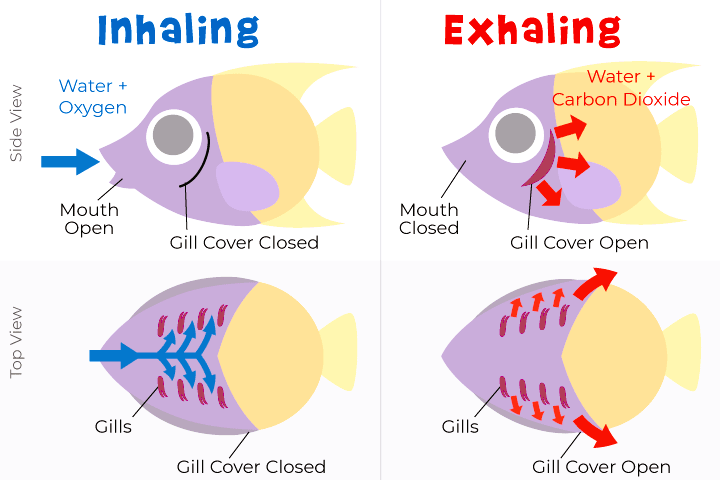
- Respiratory Organ- Gills
- Location- Projections of the skin, well supplied with blood vessels.
- Function-
- Gills allow fish to extract oxygen from water.
- Water, rich in dissolved oxygen, passes over the gills where oxygen is absorbed into the blood vessels.
- Simultaneously, carbon dioxide, a waste product of respiration, is expelled from the blood into the water through the gills.
Structure of Gills
- Specialization- Rich supply of blood vessels facilitating efficient gas exchange.
- Adaptation- Designed to maximise the surface area for increased absorption of oxygen.
Key Concepts-
- Dissolved Oxygen- Oxygen is present in a dissolved form in water, which aquatic animals utilise for respiration.
- Gill Functionality- Gills specialise in absorbing dissolved oxygen directly from water, showcasing a vital adaptation to aquatic life.
Respiration in Plants
Objective
Understanding the intricate process of respiration in plants, which involves absorbing oxygen and releasing carbon dioxide, essential for survival and energy production.
- Plants, akin to animals, respire to sustain life.
- Respiration is essential for breaking down glucose, which provides energy for various cellular functions and activities within the plant.
Mechanism of Respiration in Plants
Oxygen Uptake
- Different parts of the plant, such as roots and leaves, absorb oxygen independently from their surroundings.
- Roots absorb oxygen present in the tiny air spaces found between soil particles.
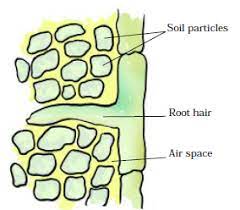
Carbon Dioxide Release
- Plants have specialised structures, like stomata on leaves, facilitating the exchange of gases, allowing them to release carbon dioxide and intake oxygen.
Cellular Respiration
Aerobic Respiration
- Occurs in cells when oxygen is available.
- It involves breaking down glucose into carbon dioxide and water, releasing a significant amount of energy.
Anaerobic Respiration
- Takes place when oxygen is scarce or unavailable.
- It occurs in parts like roots where there is limited oxygen availability, leading to different pathways of breaking down glucose.
Impact of Overwatering in Plants
- Overwatering may fill the air spaces in the soil, depriving roots of necessary oxygen.
- Lack of oxygen hampers the roots’ functionality and the plant’s overall health.
Comparison with Other Organisms-
- While the fundamental process of glucose breakdown is similar, various organisms have evolved specialised structures like lungs in humans, gills in fishes, and spiracles in insects for respiration.
- Plants use various parts like leaves and roots in direct contact with their environment to facilitate this process.
Special Structures in Plants-
Stomata-
- Microscopic openings or pores on plant leaves allow them to breathe.
Roots-
- They perform respiration by absorbing oxygen from the air spaces between soil particles.
Key Concepts-
- Differentiation between types of respiration helps understand the adaptability of plants in various conditions.
- Each part of the plant plays a role in the overall respiratory process, emphasising the integrated function of plant parts in survival.
Respiration in Yeasts
- Yeasts- Single-celled microorganisms.
- Part of the fungus family.
Type of Respiration
- Anaerobic Respiration- Process where glucose is broken down without the use of oxygen.
- Yeasts respire anaerobically.
Products of Yeast Respiration
- Alcohol (Ethanol)- Major by-product when yeasts break down glucose in the absence of oxygen.
Applications-
- Wine Production- Yeasts ferment grape juice, producing alcohol.
- Beer Production- Yeasts ferment malted grains, leading to alcohol formation.
Importance
- Yeasts play a crucial role in the alcoholic beverage industry due to their unique anaerobic respiration property.
Breathing Rate at Rest and During Exercise
Breathing Rate at Rest
- Frequency- On average, an adult breathes in and out 15–18 times per minute while at rest.
- Purpose- This frequency is sufficient to maintain the necessary oxygen and carbon dioxide levels in the body under normal conditions, ensuring that all cells receive the required oxygen for cellular processes.
Breathing Rate During Exercise
- Frequency- During heavy exercise, the breathing rate can surge up to 25 times per minute.
- Purpose- The increased rate of breathing is a response to the heightened demand for oxygen by the muscles and to expel the excess carbon dioxide generated during physical exertion.
Depth of Breaths During Exercise
- Increased Depth- While exercising, not only does the frequency of breathing increase, but the depth of breaths also augments.
- Purpose- Deeper breaths allow for a larger volume of air, and consequently oxygen, to be inhaled and utilised by the muscles, and they ensure the effective removal of carbon dioxide, a waste product of respiration.
Adaptation to Exercise
- Adjustment- The body adapts its breathing pattern during exercise to satisfy the increased oxygen demands of the body and to remove carbon dioxide more efficiently.
- Efficiency- This adaptation makes the respiratory process more effective in supporting the heightened metabolic activities occurring in the body during exercise.
Smoking, Air Impurities, and Sneezing
Smoking and Lung Health
- Damaged Lungs- Smoking is harmful to the lungs, leading to their deterioration over time.
- Cancer Linkage- There’s a robust association between smoking and lung cancer, among other types of cancer.
- Avoidance- It’s imperative to avoid smoking to preserve lung health and prevent various related health issues.
Air Quality and Respiratory Health
- Unwanted Particles- The air contains various impurities like smoke, dust, and pollen.
- Nasal Filtration- Our nasal cavity, equipped with hair, acts as a filter, trapping these particles and preventing them from entering our respiratory system.
Sneezing as a Defense Mechanism
- Expelling Foreign Particles- Sneezing is a reflex that helps in expelling foreign particles that might have bypassed the nasal hair.
- Ensuring Clean Air Entry- Through sneezing, the respiratory system ensures that only clean, dust-free air enters the body.
Etiquette and Prevention
- Covering Nose During Sneezing- It’s essential to cover the nose while sneezing to prevent the spread of expelled particles, protecting others from potential exposure to them.
Breathing for Better Life
Pranayama and Lung Capacity
- Traditional Breathing Exercise- Pranayama is a traditional breathing exercise that aids in enhancing lung capacity.
- Increased Oxygen Intake- Through regular practice, the lungs can intake more air, which means that more oxygen is made available to the body’s cells.
Energy Release
- Oxygen and Cellular Energy- With an increased supply of oxygen due to pranayama, cells can generate more energy, improving overall vitality and bodily function.
Oxygen and Carbon Dioxide Levels in Inhaled and Exhaled Air
Inhaled Air- Comprises about 21% oxygen and a mere 0.04% of carbon dioxide.
Exhaled Air- The oxygen percentage drops to approximately 16.4%, and the carbon dioxide percentage increases to around 4.4% in the air that is expelled.
Understanding Gas Exchanges
- Importance of Balance- The noted percentages in oxygen and carbon dioxide between inhaled and exhaled air indicate the gas exchange occurring in the lungs, essential for maintaining cellular respiration and overall physiological balance.
Oxygen and Organisms
Oxygen essential for humans and many organisms
- Oxygen is vital for the survival of humans and many other organisms. It is used in cellular respiration, where cells extract energy from nutrients.
Not all organisms use oxygen
- Some organisms do not use oxygen for their survival. These are usually microorganisms that thrive in environments lacking oxygen, and they perform anaerobic respiration.
Oxygen can be toxic to anaerobic organisms
- For organisms that do not utilise oxygen (anaerobic organisms), the presence of oxygen can be toxic. It can interfere with their metabolic processes and survival.
Pure oxygen can be harmful
- Breathing pure oxygen can be harmful even to organisms that rely on oxygen, like humans. In a controlled, medical setting, pure oxygen is used for specific therapeutic reasons, but prolonged exposure can lead to oxygen toxicity.
Risks of breathing pure oxygen
- Breathing pure oxygen for a prolonged period can lead to lung damage and other health issues due to oxygen toxicity. It can lead to conditions like inflammation and scarring of the lungs.
Also Check – NCERT Exemplar Solutions- Class 7 Science Chapter 6- Respiration in Organisms.
Also Check –NCERT Solutions for Class 7 Science Chapter 10 Respiration in Organisms
Also Check –Class 7 science -Chapter 10- Respiration in Organisms– Definition and Explanation of Important Keywords
Also Check –Chapter 10- Respiration in Organisms–Class 7 science Question and Answer (Short)
Also Check –Chapter 10- Respiration in Organisms–Class 7 Science – Question and Answer (Long Answer)
Also Check –Chapter 10- Respiration in Organisms–Class 7 science Question and Answer (MCQs)
Also Check –Chapter 10- Respiration in Organisms–Class 7 science- Question and Answer (Fill in the Blanks)


